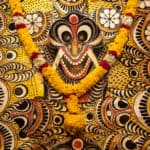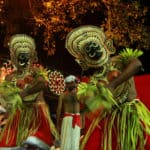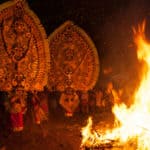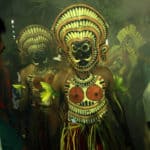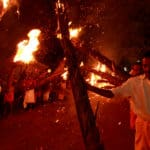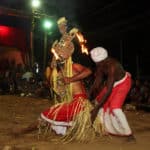Padayani which literally means “row of warriors” is a dance form belonging to the southern part of India. Performed in honour of “Bhadrakali” (i.e. an avatar of Lord Shiva) this dance form has its origins in the Pathanamthitta district in Kerala. It is mainly performed in Bhagavati temples, and involves the use of masks. Furthermore, this dance style fuses elements of theatre and music thereby making it an extremely interesting form of art. In addition, there are several versions of this dance form, and they include Kottangal Padayani, Kadammanitta Padayani, Kurampala padayani, Kallooppara Padayani, and Kunnamthanam padayani.
a. History/origin of the Padayani:
The origin of this dance form is said to be linked to a popular folklore associated with Lord Shiva. According to this legend, one fine day Goddess Kali happened to kill Daruka, an asura. Now the destruction of this demon (asura) filled Kali with ferocious rage. Worried that this rage of Kali’s if allowed to build could lead to destruction of the world, Shiva sent his boothagana servants to pacify her. It was then that these servants danced in front of Kali in an attempt to cool down her rage. It is thereby in honour of this mythological folklore that this dance form was eventually created.
b. Costumes used in the Padayani:
The essential part of the costume used in this dance form is the facial mask (i.e. kollam) used. This mask is essentially made up of lathes belonging to the areca tree. In addition, the ingredients used in preparing this mask includes kamukin pacha, kari i.e. carbon, manjalpoodi, and sindooram. Furthermore, natural colours are used to prepare this mask. There are also a number of masks that are made available for this dance, and each mask represents a specific character. For example, the Bhairavi Kollam represents Goddess Kali, Yakshi Kollam represents a fairy while Pakshi Kollam represents a bird.
c. Music involved in the Padayani:
The musical instruments used in this dance form include patayani thappu (i.e. a form of a drum), chenda (i.e. another form of a drum), para, and kumbham. In addition, the songs used in this dance form basically have been passed on from one generation of performers to another.
d. Training availability and the dance technique involved Padayani:
The unique feature about the technique involved in this dance form is the different styles available, and they include madan, marutha, yakshi, pakshi, kalan kolam, and bhairavi kolam. Furthermore, this dance involves the artist performing to all of the above mentioned styles accompanied by music. The most important style is the kalan kollam, which essentially narrates a story revolving around a small child (a devotee of Lord Shiva) and his impending death. There are no training centres/schools available for this dance neither in the state nor in the country since it is an indigenous dance style developed in a state considered to be “God’s own land”.

